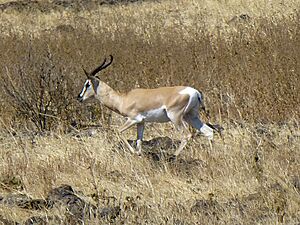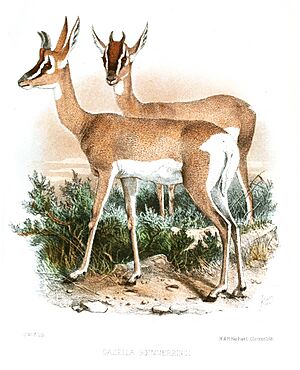Soemmerring's gazelle facts for kids
Quick facts for kids Soemmerring's gazelle |
|
|---|---|
 |
|
| Soemmerring's gazelle at Yangudi Rassa National Park, Ethiopia | |
| Conservation status | |
| Scientific classification | |
| Genus: |
Nanger
|
| Species: |
soemmerringii
|
| Synonyms | |
|
|
The Soemmerring's gazelle (its scientific name is Nanger soemmerringii) is also known as the Abyssinian mohr. This amazing animal is a type of gazelle. It lives in the Horn of Africa, which includes countries like Djibouti, Eritrea, Ethiopia, Somalia, and South Sudan.
A German doctor named Philipp Jakob Cretzschmar first described this gazelle in 1828. Scientists recognize three different kinds, or subspecies, of Soemmerring's gazelle. Sadly, it might not live in Sudan anymore. Since 1986, the International Union for Conservation of Nature (IUCN) has listed the Soemmerring's gazelle as a Vulnerable animal. This means it is at risk of becoming extinct.
Contents
About Soemmerring's Gazelle
The Soemmerring's gazelle belongs to a family of animals called Bovidae. This family includes animals like cows, goats, and antelopes. Its special scientific name is Nanger soemmerringii. It used to be grouped with other gazelles, but now it has its own group called Nanger.
This gazelle got its name from another German doctor, Samuel Thomas von Sömmerring. The Soemmerring's gazelle is quite similar to the Grant's gazelle and the Thomson's gazelle.
Different Kinds of Soemmerring's Gazelle
Scientists usually recognize three main types, or subspecies, of Soemmerring's gazelle:
- Nubian Soemmerring's gazelle (N. s. soemmeringii)
- Somali Soemmerring's gazelle (N. s. berberana)
- Borani Soemmerring's gazelle (N. s. butteri)
There is also a smaller group of these gazelles on Dahlak Kebir island. They might be a special subspecies too!
What Soemmerring's Gazelles Look Like
Soemmerring's gazelles are tall and graceful animals. Their fur is tan on their sides and turns white on their bellies. They have long, black horns that curve backwards.
These gazelles stand about 75 to 90 centimeters (about 2.5 to 3 feet) tall at their shoulder. They weigh between 35 and 45 kilograms (about 77 to 99 pounds). Soemmerring's gazelles look so much like Grant's gazelles that people often mix them up.
Where Soemmerring's Gazelles Live
Soemmerring's gazelles are originally from the Horn of Africa. You can find them in Djibouti, Eritrea, Ethiopia, Somalia, and South Sudan. Sadly, they no longer live in Sudan.
They like to live in open areas with bushes and acacia trees. They also live in grasslands with only a few trees. Long ago, some Soemmerring's gazelles ended up on Dahlak Kebir island. Over time, they became a smaller, dwarf version of the gazelles on the mainland.
Soemmerring's Gazelle Life and Habits
What Soemmerring's Gazelles Eat
These gazelles enjoy eating leaves from acacia trees and other bushes. They also munch on different kinds of grasses and herbs.
Reproduction and Life Cycle
Male Soemmerring's gazelles might claim a territory for a short time. These animals can live for up to 14 years.
Threats to Soemmerring's Gazelles
The Soemmerring's gazelle is listed as Vulnerable on the IUCN Red List. This means their numbers are decreasing, and they face a high risk of becoming extinct in the wild.
In the past, people used to hunt gazelles by building large stone traps. They would guide herds of gazelles into these traps, making it easy to catch them. This hunting method started a very long time ago and continued until the early 1900s.
Many types of gazelles have been hunted for food throughout history. Soemmerring's gazelles are not studied very much because there are so few of them left. In some areas where they used to live, they have completely disappeared. This is due to hunting and the destruction of their natural homes.



